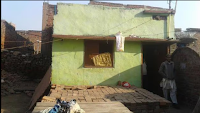What do the first Prime Minister of Mauritius, the Grand Trunk Road, Ustad Bismillah Khan, and Bhojpuri cinema have in common? The answer lies in the former district of Bihar—Shahabad or as it got historically renamed as Arrah. This district, now divided into Kaimur, Rohtas, Buxar, and Bhojpur, was once a region of immense historical significance. It has witnessed landmark events and produced influential figures who have shaped politics, arts, and entertainment. However, today, it faces an average poverty rate of 26.06%, approximately 1.74 times higher than India’s national average of 14.96%, according to 2023 data.
_from_a_manuscript_of_Tarikh-i-Khandan-i-Timuriya,_prepared_by_the_court_painters_of_Mughal_emperor_Akbar,_circa_16th_century.jpg) |
Sher Shah Suri
Image sourced from Wikipedia |
One of the most decisive battles against the East India Company was fought at Buxar, marking a turning point for British rule in India. The victory at Buxar solidified Robert Clive’s authority, enabling the British to formally take control of Bengal Presidency in 1764, which remained under Company rule for a century. Before British dominance, and even preceding the Mughal Empire’s consolidation, the Sur Empire played a crucial role in shaping North India’s political landscape. Sher Shah Suri, the founder of this empire, was born in Sasaram in the late 1400s. He constructed the Grand Trunk Road, then known as Sadak-e-Azam, which the British later referred to as the Long Walk. This historic road, stretching from Kabul to Chittagong, passes through Sasaram, near Sher Shah Suri’s grand mausoleum. The region also boasts the formidable Rohtasgarh Fort, which served as a strategic stronghold during Mughal-Sur conflicts and later provided refuge to notable figures such as Shah Jahan, Mir Qasim, and the 1857 rebellion hero, Kunwar Singh.
 |
Apravasi Ghat, Port Louis
The main site where indentured labourers were
brought in by the British
Source: Britannica |
Shahabad’s influence extends far beyond India’s borders. The 19th-century indentured labor migration from Bihar and northern India saw thousands of Indians being taken to Mauritius, many of them from Shahabad. The ‘Girmitiya’ labor system led to countless deaths and failed escape attempts, while those who survived became part of a new cultural identity. This is why Indian names, cultural traditions, and even the currency (Rupees) remain prevalent in Mauritius today. Notably, several of the country's key political figures—including the first Prime Minister, Sir Seewoosagur Ramgoolam, as well as Navin Ramgoolam, Sir Anerood Jugnauth, and Pravind Jugnauth—trace their ancestry back to Shahabad.
 |
Popular image of Kunwar Singh
Source: Wikipedia |
The 1857 revolt took an intense turn in Bihar under the leadership of Kunwar Singh. As the ruler of Jagdishpur, he led the mutiny against the British by attacking their headquarters in Arrah. However, his significance extends beyond this single attack. What made him truly remarkable was his resilience—he was never captured by the British, despite being nearly 80 years old. Even after the British recaptured Arrah, Kunwar Singh continued his campaign, leading successful battles in Azamgarh. His unyielding spirit and strategic brilliance earned him a place among the most celebrated freedom fighters of the rebellion.
 |
Ganga Mayya Tohre Piyari Chadhaibo
Soundtrack album poster, 1963
|
Shahabad also played a crucial role in the birth of Bhojpuri cinema. Bishwanath Prasad Shahabadi, a producer from Arrah, produced the first Bhojpuri film, ‘Ganga Maiyya Tohe Piyari Chadhaibo’ in 1963. The film was conceptualized and written by Nazir Hussain, a man with an extraordinary history. Before entering the film industry, Hussain had served in the Indian National Army under Subhas Chandra Bose in Malaya and Singapore, having previously fought on multiple fronts during World War II. The idea of creating a Bhojpuri film industry was encouraged by none other than India’s first President, Dr. Rajendra Prasad, who discussed it with Hussain in the early 1960s.
Another celebrated figure from Shahabad is Ustad Bismillah Khan, the legendary shehnai maestro. Born as Qamaruddin Khan in 1916 in Dumraon (now in Buxar district), he later earned the title ‘Bismillah’ and became synonymous with Indian classical music. His legacy includes a historic performance at the Red Fort on August 15, 1947, and a series of prestigious awards, including the Padma Shri (1961), Padma Bhushan (1968), Padma Vibhushan (1980), and the Bharat Ratna (2001). He even appeared in Satyajit Ray’s film ‘Jalsaghar’ (1958). Although he spent most of his life in Varanasi, his ancestral home in Dumraon still holds historical significance, despite its present state of neglect.
 |
Ustad Bismillah Khan's birth house in
Dumraon village, Buxar
Source: Hindustan Times
|
The district of Shahabad was first bifurcated in 1972 into Rohtas and Bhojpur, with Sasaram and Arrah serving as their respective headquarters. Further divisions in 1991 and 1992 led to the creation of Kaimur, headquartered in Bhabua. The reason the name ‘Shahabad’ was not retained after these bifurcations lies in its origin—Mughal Emperor Babur had named the area ‘Shahabad’ after establishing his rule in Arrah. Post-independence, efforts were made to erase remnants of Mughal nomenclature, leading to the disappearance of the district’s historical name.
From its role in defining Indian history to its global connections, Shahabad remains an integral yet often overlooked chapter in India’s past. Its contributions to politics, warfare, arts, and cinema continue to shape narratives both within and beyond India’s borders.
_from_a_manuscript_of_Tarikh-i-Khandan-i-Timuriya,_prepared_by_the_court_painters_of_Mughal_emperor_Akbar,_circa_16th_century.jpg)















0 Comments